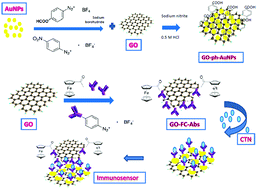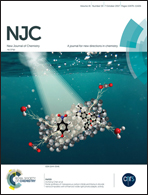A label-free electrochemical immunosensor based on gold nanoparticles and graphene oxide for the detection of tumor marker calcitonin
Abstract
A label-free ultrasensitive electrochemical immunosensor has been designed for the detection of calcitonin, a medullary thyroid carcinoma tumor marker. The immunosensor was fabricated by deposition of gold nanoparticles and graphene oxide on the activated surface of a glassy carbon electrode. The incorporation of the nanocomposite leads to the increased surface area of the immunosensor, which translates into an enhanced sensitivity. The modified surface of the immunosensor improves the loading of anti-calcitonin capture antibody. Furthermore, the gold nanoparticles and graphene oxide nanocomposite are coupled with the sensor surface through aryldiazonium salts via covalent bonds, which stabilizes the sensing interface. The anti-calcitonin detection antibodies are immobilized on the sensor surface that is modified using ferrocene-graphene oxide molecules for detecting calcitonin level. The signal of the modified sensor is determined based on the shift of peak current, which is a consequence of the change in surface charge due to the antigen–antibody sandwich-type immunoreaction. Under optimized conditions, the output peak current shift was directly proportional to the calcitonin concentration, with a dynamic linearity range from 0.001 to 1.0 ng mL−1 and a detection limit as low as 0.7 pg mL−1. The designed immunosensor exhibited an acceptable selectivity for the detection of human calcitonin with a high sensitivity at low concentrations.



 Please wait while we load your content...
Please wait while we load your content...